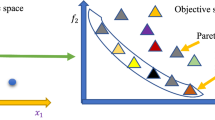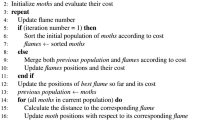Abstract
Metaheuristic algorithms have popularly been used to solve a wide range of complex engineering optimization problems. In order to solve the problems with two or more objectives multi-objective algorithms (MOAs) are used. Application of MOAs to solve multiple conflicting objectives yields a Pareto-optimal solution set. In this paper, we propose a multi-objective decomposition-based moth flame optimization (MOMFO/D) algorithm, that decomposes the objectives into multiple single objectives which are optimized simultaneously. The algorithm is used to solve the relay node placement problem, that is modeled as a bi-objective problem with the goal of minimization of average intra-cluster distance and average hop-count to improve the network lifetime. The Pareto-optimal fronts obtained through the simulations are evaluated using three distinct quality indicators namely the Inverted Generational Distance, Spacing Metric and Maximum Spread in order to evaluate the performance. The obtained results considered over a number of runs are compared with other existing optimizers in the literature such as multi-objective non-dominated sorted moth flame optimizer, and multi-objective evolutionary algorithm based on decomposition. The results demonstrate the superiority in the performance of the proposed algorithm over others. The statistical analysis of the experimental work has been carried out by conducting Friedman’s and Quade test.













Similar content being viewed by others
References
Hussain, K., Salleh, M. N. M., Cheng, S., & Shi, Y. (2018). Metaheuristic research: A comprehensive survey. Artificial Intelligence Review, 52, 2191–2233.
Das, S., Maity, S., Qu, B.-Y., & Suganthan, P. N. (2011). Real-parameter evolutionary multimodal optimization—A survey of the state-of-the-art. Swarm and Evolutionary Computation, 1(2), 71–88.
Tejani, G. G., Savsani, V. J., Patel, V. K., & Savsani, P. V. (2018). Size, shape, and topology optimization of planar and space trusses using mutation-based improved metaheuristics. Journal of Computational Design and Engineering, 5(2), 198–214.
Li, W., Özcan, E., & John, R. (2017). Multi-objective evolutionary algorithms and hyper-heuristics for wind farm layout optimisation. Renewable Energy, 105, 473–482.
Abidi, B., Jilbab, A., & Haziti, M. E. (2017). Wireless sensor networks in biomedical: Wireless body area networks. In Europe and MENA cooperation advances in information and communication technologies (pp. 321–329). Springer.
Liu, Y. M., Liu, Y. M., Xu, H. L., & Teo, K. L. (2018). Forest fire monitoring, detection and decision making systems by wireless sensor network. In 2018 Chinese Control And Decision Conference (CCDC). IEEE.
Sun, Z., Yimin, X., Liang, G., & Zhou, Z. (2018). An intrusion detection model for wireless sensor networks with an improved v-detector algorithm. IEEE Sensors Journal, 18(5), 1971–1984.
Lloyd, E. L., & Xue, G. (2007). Relay node placement in wireless sensor networks. IEEE Transactions on Computers, 56(1), 134–138.
Zhang, Q., & Li, H. (2007). MOEA/D: A multiobjective evolutionary algorithm based on decomposition. IEEE Transactions on evolutionary computation, 11(6), 712–731.
Mirjalili, S. (2015). Moth-flame optimization algorithm: A novel nature-inspired heuristic paradigm. Knowledge-Based Systems, 89, 228–249.
Amine Bouhlel, M., Bartoli, N., Regis, R. G., Otsmane, A., & Morlier, J. (2018). Efficient global optimization for high-dimensional constrained problems by using the kriging models combined with the partial least squares method. Engineering Optimization, 50, 2038–20053.
Sapre, S., & Mini, S. (2018). Optimized relay nodes positioning to achieve full connectivity in wireless sensor networks. Wireless Personal Communications, 99(4), 1521–1540.
Chen, C.-P., Mukhopadhyay, S. C., Chuang, C.-L., Liu, M.-Y., & Jiang, J.-A. (2015). Efficient coverage and connectivity preservation with load balance for wireless sensor networks. IEEE Sensors Journal, 15(1), 48–62.
Mavrovouniotis, M., Li, C., & Yang, S. (2017). A survey of swarm intelligence for dynamic optimization: Algorithms and applications. Swarm and Evolutionary Computation, 33, 1–17.
Sapre, S., & Mini, S. (2019). Opposition-based moth flame optimization with cauchy mutation and evolutionary boundary constraint handling for global optimization. Soft Computing, 23(15), 6023–6041.
Mohajerani, A., & Gharavian, D. (2016). An ant colony optimization based routing algorithm for extending network lifetime in wireless sensor networks. Wireless Networks, 22(8), 2637–2647.
Hashim, H. A., Ayinde, B. O., & Abido, M. A. (2016). Optimal placement of relay nodes in wireless sensor network using artificial bee colony algorithm. Journal of Network and Computer Applications, 64, 239–248.
Ma, C., Liang, W., & Zheng, M. (2018). Delay constrained relay node placement in wireless sensor networks: A subtree-and-mergence-based approach. Mobile Networks and Applications, 23(5), 1220–1232.
Ye, W., Luo, J., Wu, W., & Xu, S. (2019). Energy-efficient relay node placement in wireless heterogeneous networks with capacity constraints. IEEE Access, 1–1.
Vijayalakshmi, K., & Anandan, P. (2019). A multi objective Tabu particle swarm optimization for effective cluster head selection in WSN. Cluster Computing, 22, 12275–12282.
Sun, Y., Dong, W., & Chen, Y. (2017). An improved routing algorithm based on ant colony optimization in wireless sensor networks. IEEE Communications Letters, 21(6), 1317–1320.
Magán-Carrión, R., Camacho, J., García-Teodoro, P., Flushing, E. F., & Di Caro, G. A. (2016). DRNS: Dynamical relay node placement solution. In Advances in practical applications of scalable multi-agent Systems (PAAMS) (pp. 273–276). Springer.
Peiravi, A., Mashhadi, H. R., & Javadi, S. H. (2013). An optimal energy-efficient clustering method in wireless sensor networks using multi-objective genetic algorithm. International Journal of Communication Systems, 26(1), 114–126.
Perez, A. J., Labrador, M. A., & Wightman, P. M. (2011). A multiobjective approach to the relay placement problem in WSNS. In 2011 IEEE wireless communications and networking conference (pp. 475–480).
Lanza-Gutierrez, J. M., & Gomez-Pulido, J. A. (2015). Assuming multiobjective metaheuristics to solve a three-objective optimisation problem for relay node deployment in wireless sensor networks. Applied Soft Computing, 30, 675–687.
Lanza-Gutierrez, J. M., & Gomez-Pulido, J. A. (2017). A gravitational search algorithm for solving the relay node placement problem in wireless sensor networks. International Journal of Communication Systems, 30(2), e2957.
Coello Coello, C. A. (1999). A comprehensive survey of evolutionary-based multiobjective optimization techniques. Knowledge and Information Systems, 1(3), 269–308.
Elsakaan, A. A., El-Sehiemy, R. A., Kaddah, S. S., & Elsaid, M. I. (2018). An enhanced moth-flame optimizer for solving non-smooth economic dispatch problems with emissions. Energy, 157, 1063–1078.
Li, W. K., Wang, W. L., & Li, L. (2018). Optimization of water resources utilization by multi-objective moth-flame algorithm. Water Resources Management, 32, 3303–3316.
Allam, D., Yousri, D. A., & Eteiba, M. B. (2016). Parameters extraction of the three diode model for the multi-crystalline solar cell/module using moth-flame optimization algorithm. Energy Conversion and Management, 123, 535–548.
Martínez, S. Z., & Coello, C. A C. (2012). A direct local search mechanism for decomposition-based multi-objective evolutionary algorithms. In 2012 IEEE Congress on evolutionary computation (CEC) (pp. 1–8). IEEE.
Deb, K., & Jain, H. (2014). An evolutionary many-objective optimization algorithm using reference-point-based nondominated sorting approach, part i: Solving problems with box constraints. IEEE Transactions on Evolutionary Computation, 18(4), 577–601.
Li, H., & Zhang, Q. (2009). Multiobjective optimization problems with complicated pareto sets, MOEA/D and NSGA-II. IEEE Transactions on Evolutionary Computation, 13(2), 284–302.
Ke, L., Zhang, Q., & Battiti, R. (2013). MOEA/D-ACO: A multiobjective evolutionary algorithm using decomposition and antcolony. IEEE Transactions on Cybernetics, 43(6), 1845–1859.
Zhang, Q., Zhou, A., Zhao, S., Suganthan, P. N., Liu, W., & Tiwari, S. (2008). Multiobjective optimization test instances for the CEC 2009, special session and competition. University of Essex, Colchester, UK and Nanyang technological University, Singapore, special session on performance assessment of multi-objective optimization algorithms, technical report, 264.
Savsani, V., & Tawhid, M. A. (2017). Non-dominated sorting moth flame optimization (NSMFO) for multi-objective problems. Engineering Applications of Artificial Intelligence, 63, 20–32.
Deb, K., Pratap, A., Agarwal, S., & Meyarivan, T. A. M. T. (2002). A fast and elitist multiobjective genetic algorithm: NSGA-II. IEEE Transactions on Evolutionary Computation, 6(2), 182–197.
Yang, X.-S., Karamanoglu, M., & He, X. (2014). Flower pollination algorithm: A novel approach for multiobjective optimization. Engineering Optimization, 46(9), 1222–1237.
Bai, J., & Liu, H. (2016). Multi-objective artificial bee algorithm based on decomposition by PBI method. Applied Intelligence, 45(4), 976–991.
Coello, C. A. C., & Cortés, N. C. (2005). Solving multiobjective optimization problems using an artificial immune system. Genetic Programming and Evolvable Machines, 6(2), 163–190.
Schott, J. R. (1995). Fault tolerant design using single and multicriteria genetic algorithm optimization. Technical report, Air Force Institute of Technology Wright-Patterson Air Force Base Ohio.
Jiang, S., & Yang, S. (2017). A steady-state and generational evolutionary algorithm for dynamic multiobjective optimization. IEEE Transactions on Evolutionary Computation, 21(1), 65–82.
Mittal, N., Singh, U., & Sohi, B. S. (2019). An energy-aware cluster-based stable protocol for wireless sensor networks. Neural Computing and Applications, 31(11), 7269–7286.
Yildiz, H. U., Temiz, M., & Tavli, B. (2015). Impact of limiting hop count on the lifetime of wireless sensor networks. IEEE Communications Letters, 19(4), 569–572.
Coello, C. A. C. (2002). Theoretical and numerical constraint-handling techniques used with evolutionary algorithms: A survey of the state of the art. Computer Methods in Applied Mechanics and Engineering, 191(11–12), 1245–1287.
Kramer, O., & Schwefel, H.-P. (2006). On three new approaches to handle constraints within evolution strategies. Natural Computing, 5(4), 363–385.
Author information
Authors and Affiliations
Corresponding author
Additional information
Publisher's Note
Springer Nature remains neutral with regard to jurisdictional claims in published maps and institutional affiliations.
Rights and permissions
About this article
Cite this article
Sapre, S., Mini, S. Moth flame optimization algorithm based on decomposition for placement of relay nodes in WSNs. Wireless Netw 26, 1473–1492 (2020). https://doi.org/10.1007/s11276-019-02213-1
Published:
Issue Date:
DOI: https://doi.org/10.1007/s11276-019-02213-1




